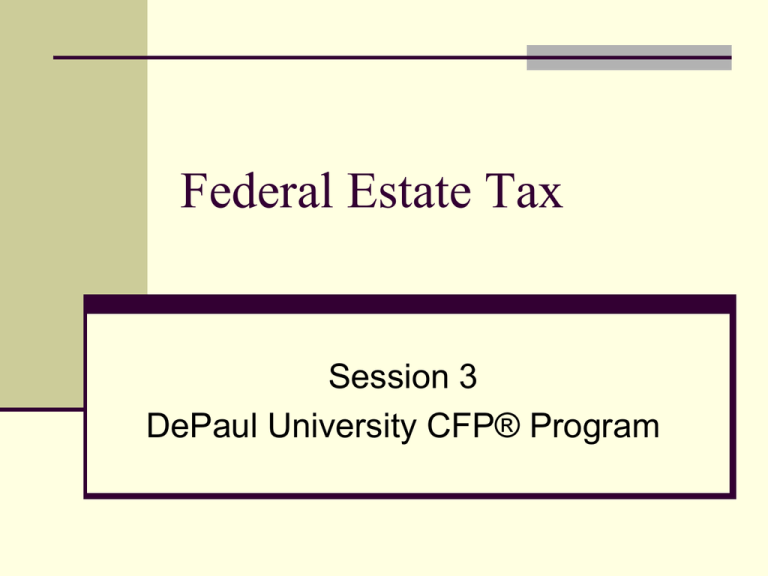
Federal Estate Tax
Session 3
DePaul University CFP® Program
What Is Federal Estate Tax?
Federal estate tax (FET)is tax on certain
transfers of property at death.
Such property may include:
Cash
Securities
Real estate
Business interests
The principal of certain trusts
Other assets
Whether or not an asset goes through
probate does not determine FET inclusion
DePaul University All rights reserved.
2
Federal Estate Tax
Federal estate tax (FET) is an excise tax on the
privilege of giving your property away.
Federal estate tax is filed using Form 706
Personal representative must file and pay the tax
Executor or administrator
Form 706 required when:
Decedent’s gross estate >$5,120,000 million (2012) or
Decedent’s gross estate plus adjusted taxable gifts >
$5,120,000 million (2012)
Federal estate taxes are due within nine months from the date of
the decedent's death
A 6-month extension for filing (not paying) is generally
granted
DePaul University All rights reserved.
3
Question 3-1
For which of the following estates would Form
706 most likely have to be filed?
A.
B.
C.
D.
Lou’s because he died owning more than $3 million in
property. (made no lifetime gifts)
Stu’s because he died owning more than $3 million in property
and had gifted an additional $4 million to his children.
Sue’s because she died owning more than $3 million in
property and had gifted an additional $4 million to her
husband.
Rue’s because she died owning more than $3 million in
property and had gifted an additional $1 million to her
grandsons.
DePaul University All rights reserved.
4
The Federal Estate Tax Formula
Federal Estate Tax Formula:
Gross estate
- Adjustments (debts, expenses, state death taxes, casualty loss)
= Tentative taxable estate (aka adjusted gross estate)
- marital and charitable deductions (generally unlimited)
- state death tax
= Taxable estate
+ Adjusted taxable gifts (post-1976)
= Tax base
X tax rate
= Tentative estate tax
- Credits (applicable credit, prior gift tax, other)
= Net estate tax due
DePaul University All rights reserved.
5
Estate Tax Property Exemptions
Over Time
Year
Estate Tax Exemption
Top Estate Tax Rate
1997
$600,000
55%
1998
$625,000
55%
1999
$650,000
55%
2000
$675,000
55%
2001
$675,000
55%
2002
$1,000,000
50%
2003
$1,000,000
49%
2004
$1,500,000
48%
2005
$1,500,000
47%
2006
$2,000,000
46%
2007
$2,000,000
45%
2008
$2,000,000
45%
2009
$3,500,000
45%
*2010
$5,000,000 or $0
35% or 0%
2011
$5,000,000
35%
**2012
$5,120,000
35%
2013
$1,000,000
55%
DePaul University All rights reserved.
6
35-Percent Rate to Sunset
The Tax Relief, Unemployment Insurance
Reauthorization, and Job Creation Act
("TRA 2010") enacted December 17, 2010.
Reinstated the estate tax retroactively back to January 1, 2010.
Also set new rules for the estates of decedents who die in
2011 and 2012.
This law, however, is set to sunset on December 31, 2012.
Unless new legislation is enacted, in 2013 the estate tax laws
will revert back to the 2001/2002 provisions.
DePaul University All rights reserved.
7
Fewer Americans Subject to Estate
Tax
Under current law, fewer Americans will be
subject to federal estate tax than in previous
years due to:
2012 federal estate tax exemption at
$5,120,000, plus
Portability of the unused exemption to
surviving spouses,.
DePaul University All rights reserved.
8
The Gross Estate
A decedent’s gross estate includes all property
in which the decedent held an interest at death.
The gross estate is calculated before ANY
deductions are applied.
Allowable deductions then reduce the gross
estate.
DePaul University All rights reserved.
9
Gross Estate Inclusion Examples
The following are examples of property included in a
decedent’s gross estate:
Fee simple property (individually owned)
Joint tenancy property
One half included if spousal
Non-spousal: proportion included if consideration
furnished by survivor can be proven
Decedent’s fractional interest of TIC property
Revocable trust property
DePaul University All rights reserved.
10
Gross Estate Inclusion Examples
continued:
Property in some “tainted” irrevocable trusts
Life insurance
Owned by decedent
Transferred within three years of death
Reversionary Interests
Survivor annuities
…….more
DePaul University All rights reserved.
11
Question 3-2
Which of the following assets would not be
included in Mark’s gross estate?
A. His municipal bond portfolio
B. His IRA naming his wife, Anne as
beneficiary.
C. A right to receive income until death from his
grandmother’s trust
D. His jeep
DePaul University All rights reserved.
12
Life Insurance Policies
Included in Gross Estate
A policy of life insurance that insures the life of another
and owned by the decedent at death is included in the
gross estate.
Generally, value of policy is replacement value but type of
policy may determine valuation method:
Newly issued policies, the value = premiums paid.
“Paid up” one-time, single premium policies, value
= carrier’s current cost for identical policy.
Policies in force for some time on which additional
premiums are due, value = interpolated terminal
reserve amount plus unearned premiums
DePaul University All rights reserved.
13
Life Insurance Proceeds Generally
Included in Gross Estate
The proceeds of a life insurance insuring the decedent’s
life is included in the gross estate if the decedent held
“incidents of ownership” at death.
Incidents of ownership include:
Right to name/change beneficiary
Right to assign ownership
Right to make policy loans
….more
Proceeds are included in the gross estate for FET
purposes regardless of who actually receives them.
DePaul University All rights reserved.
14
When Life Insurance Is Not
Included In The Gross Estate
Proceeds of life insurance on the decedent’s
life will not be included in the gross estate
when:
The decedent gives away the policy more than 3 years
prior to death retaining no incidents of ownership
This includes the transfer to an irrevocable life insurance
trust (“ILIT”)
Life insurance where decedent held no incidents of
ownership in the policy at death and decedent’s estate is
not named beneficiary
DePaul University All rights reserved.
15
Question 3-3
Six weeks after transferring his life insurance to
an irrevocable trust, Rick was hit by a bus.
What happens in terms of his gross estate?
A.
B.
C.
D.
The insurance is not in his gross estate because it was held in
trust.
The insurance is not in his gross estate because insurance is
not a financial asset.
The insurance is not in his gross estate because Rick’s death,
although within three years of the transfer was accidental.
The insurance is in his gross estate because Rick held
incidents of ownership within three years of his death.
DePaul University All rights reserved.
16
Other Assets Not Included in a
Decedent’s Gross Estate
The following assets are not generally included
in a decedent’s gross estate
Gifted property over which decedent retained
no powers of control/enjoyment at death:
Property over which decedent held only a
non-general power of appointment
DePaul University All rights reserved.
17
Property in the Gross Estate
Property in a decedent’s gross estate includes:
Individually owned property
One’s fractional interest in TIC property
50% of spousal JTWROS property
50% of community property
100% of non-spousal JTWROS property unless
estate can prove survivor’s contribution
DePaul University All rights reserved.
18
Property in the Gross Estate
Property in a decedent’s gross estate includes:
Proceeds of life insurance with incidents of ownership
Proceeds of life insurance transferred within 3 years
of death
Retained interest property
Reversionary interest property
Personal effects
DePaul University All rights reserved.
19
The Three-Year Rule
Certain transfers made within 3 years of death are included
in the gross estate including:
Gift tax actually paid by the decedent
Only the tax paid, not the amount of the gift
To discourage reduction of the estate by the taxexclusive nature of the gift tax
Known as “grossing up” the estate
Severance of a retained interest less than 3 years prior to
death
Life insurance transferred by the insured to anyone,
including a spouse or trust
DePaul University All rights reserved.
20
Valuation of Assets for Federal
Estate Tax Purposes
In determining the gross estate, assets are
generally reported at fair market value (FMV)
Decedent’s full or proportional interest shown
Certain discounts may apply
Lack of marketability discount
Lack of control discount (minority discount)
Key person discount
Co-ownership discount
Blockage discount
DePaul University All rights reserved.
21
The Alternate Valuation Date
(AVD)
Some estates may elect to value the gross estate as of
the date 6 moths after the date of death (AVD).
To use the alternative valuation date, all three
requirements must be met:
Electing the AVD must decrease the value of the GE
Electing the AVD must decrease the amount of FET
actually due
The PR who files the 706 must make the proper
election on the return.
This election must be made within 1 year after the
due date of the federal estate tax return (including
extensions).
DePaul University All rights reserved.
22
Using the AVD
If the alternate valuation date value is elected it applies
to all assets in the gross estate, except:
Assets sold between death and the AVD are valued
at sales price
Assets that diminish in value over time by their
nature, e.g., annuities, royalties and MOG interests
subject to depletion
Possible disadvantage: use of AVD will reduce the
basis in the assets received by distributees
DePaul University All rights reserved.
23
AVD Example
Butch dies on January 1, 2012, owning 100
shares of Technotawk Inc, common stock
having a date of death value @$75 per share.
On July 1, 2012 that stock has a FMV of $50
per share.
If Butch’s PR elects the AVD the stock is
valuated at $5,000 in Butch’s estate
If Butch’s Will gives that stock to his daughter,
her basis for capital gains purposes is $5,000
DePaul University All rights reserved.
24
Question 3-4
Which of the following assets would possibly
not qualify for AVD treatment on the Form 706?
A. An IRA owned by Fred, who died at age 77.
B. A municipal bond portfolio owned by Marilyn.
C. Rita’s house
D. Arthur’s mutual funds
DePaul University All rights reserved.
25
Lack of Marketability and
Minority Discounts
The value of business interests transferred to
family members may be reduced by lack of
marketability and/or minority discounts.
A lack of marketability discount is a reduction in the
value of the property due to the difficulty or inability of
the owner to sell the property to a third person.
A minority discount is a reduction in the value of the
property since the interest does not provide for
control of the entity.
DePaul University All rights reserved.
26
Question 3-5
The minority interest discount is most likely to
be available for valuating transfers of:
A. Real property
B. Publicly traded securities
C. Stock in a closely held business
D. Bonds
DePaul University All rights reserved.
27
Lack of Marketability and
Minority Discounts Example
Example, if Stu’s estate transfers an interest in his
closely-held business valued at $18,000, the estate
may use lack of marketability and minority interest
discounts and perhaps reduce the value of the gift for
estate tax purposes from $18,000 to $12,000.
DePaul University All rights reserved.
28
Key Person Discount
The key person discount is an amount or percentage
deducted from the value of an ownership interest to
reflect the reduction in value resulting from the actual or
potential loss of a key person, often the founder, in a
business enterprise.
Factors used to evaluate whether to apply a key-person
discount include the:
Company’s relationships with customers and suppliers,
Nature of the business,
Key person’s actual duties and activities, and
Quality and depth of the company’s management team.
DePaul University All rights reserved.
29
Co-Ownership Discount
The co-ownership discount reflects a transferee
receiving a fractional interest in real property.
This reflects that all current owners may not have
similar objectives.
Example: Your late mother left you her ½ interest
in a building she owned with her sister (your aunt).
Your aunt has no wish to sell the building and it
may be difficult to find a buyer to co-own property
with your aunt.
Discount reflects lower probability of turning the
asset into immediate cash.
DePaul University All rights reserved.
30
Blockage Discount
A blockage discount is a deduction from the price of a
publicly traded stock. The discount may be available
when the block of stock to be valued is so large (relative
to the volume of actual sales on the existing market)
that the block could not be quickly liquidated without
depressing the market price.
Value of gross estate is a “snapshot” on the date of
death. Bill Gates’ 460MM shares of MSFT (10X daily
volume is a different picture than someone else’s 400
shares.
DePaul University All rights reserved.
31
Vaulating Publicly Traded Stocks
Publicly traded stocks are valuated at the
average/mean of the high and low prices on the date of
death multiplied by the number of shares the decedent
owned.
Not the settlement price
Note: If the death occurs on a day when the stock
market is closed, then the average prices for the
stock on the trading days immediately before and
after the date of death are used
DePaul University All rights reserved.
32
Stock Valuation Example
The closing price is not used. If a stock's price
fluctuated between ten and twelve dollars on the date
of death, the average of $11.00 per share is used for
determining the value of the stock.
If the death occurred on a weekend or holiday when
the market is closed, the high and low values for the
trading date prior to the death and those of the next
trading date are "re-averaged."
DePaul University All rights reserved.
33
Question 3-6
For transfer tax valuation purposes, publicly
traded stock is most likely to be valuated at its:
A. FMV
B. Settlement price
C. Closing tick
D. Mean price
DePaul University All rights reserved.
34
Valuating Mutual Fund Shares
For mutual funds, the gross estate includes the
"bid" value, or public redemption price, of the
fund as of the date of death.
If the death occurs on a weekend or holiday, the
fund is valued based on the public redemption
or bid value as of the trading date preceding the
date of death.
DePaul University All rights reserved.
35
Valuating Bonds
Bonds must include accrued interest when their value is
determined. Since bonds typically pay interest twice a
year, unless the owner dies on the date of payment, the
interest from the date of the last payment through the
date of death must be computed and included.
If there is no high and low value for a bond on the date of the
death, the average of the closing price on the date of death and
the closing price on the trading day preceding the date of death
is used.
DePaul University All rights reserved.
36
Valuating US Savings Bonds
United States Series E, EE, H, and HH, Savings
Bonds are valued at the price for which they
could be redeemed during the month of death.
The redemption value of such bonds, which
depends on both the month and year of
purchase as well as the redemption date, is
available on a website published by the
federal government.
DePaul University All rights reserved.
37
Single Life Annuties
Single(pure) life annuities are not included in
the gross estate for FET purposes.
Why?
Because payments stop on the death of the
(one) annuitant.
Thus, nothing can be “transferred” to another
party.
Also, nothing to include in probate estate.
DePaul University All rights reserved.
38
Question 3-7
How is a single life annuity valued for Federal
Estate Tax purposes?
A. At FMV
B. At its intrinsic value
C. At its alternate valuation day value
D. At zero
DePaul University All rights reserved.
39
Survivor Annuities
The present value of a survivor’s interest in an annuity
having a survivorship feature is included in the
(transferor’s) decedent’s gross estate.
Contracts include
Joint and survivor annuities
Refund annuities
Term certain annuities before term completed
If there is no survivorship feature, no amount is
included in the decedent’s gross estate because no
value is transferred by the decedent
DePaul University All rights reserved.
40
Valuating Real Estate
The value of real property is determined by written
appraisal.
For a single family residence, the appraisal can be
made by a local real estate broker or agent.
The appraisal should describe the property, its
value, and how that value was determined.
Similar agents or brokers, using the same
procedures and submitting the written appraisal as
mentioned, can value unimproved property valued
at $250,000 or less.
DePaul University All rights reserved.
41
Valuating Commercial Real Estate
Commercial property, including office buildings,
apartment complexes and farms need to be appraised
by a qualified appraiser.
Costs that would result from a sale, including future
brokerage commissions, etc. are normally excluded
from determining the value of real property.
If the property includes or consists of a farm or ranch,
any farm equipment, livestock, stored seeds and
fertilizers as well as growing or harvested crops are
valued separately.
DePaul University All rights reserved.
42
Valuating Farm and Business
Real Property
If a farm or real property used in a closely held business
is part of the gross estate, and the requirements are
met, the executor may elect to value the property at its
special use value, rather than its fair market value.
If a farm or real property used in a closely held business is
part of the gross estate, the executor may elect to value
the property at its special use value, rather than its fair
market value.
The real property is then valued at its discounted business
use value, not its fair market value at its highest and best
use.
DePaul University All rights reserved.
43
Valuating Autos, Planes, and Boats
The value of all vehicles is determined
individually using the sale price as of the date of
death. The value of automobiles may be
determined by consulting the "Kelley Blue
Book" or similar publications, and RVs,
motorcycles, mobile homes, boats, or planes
have similar publications that can be used to
determine their value.
DePaul University All rights reserved.
44
Valuating Fine Art
Art objects, including paintings, sculptures, tapestries,
silverware, and other artifacts, are subject to the
general valuation rules for estate tax purposes.
Documentation required depends on the value of the
articles.
An art object valued at no more than $100 may be
grouped with other articles on a room-by-room
appraisal, with a separate value given for each item
named. An executor is also allowed to submit an
aggregate value as appraised by a competent
appraiser or dealer.
DePaul University All rights reserved.
45
Valuating Fine Art
Continued:
For articles with artistic or intrinsic value of more than
$3,000 or a collection of similar articles valued at more
than $10,000, the appraisal must be made under oath by
an expert who must also attach a statement of
qualifications.
When an art object has a value in excess of $20,000, the
valuation is automatically reviewed by the Art Valuation
Group (National Office) of the Engineering and Valuation
Branch of the IRS for possible audit. When the value is
greater than $50,000 and substantiated valuation is
desired, the IRS provides a procedure for obtaining this
secure art value.
DePaul University All rights reserved.
46
Valuating Foreign Currency
Foreign currency is valued at the commercial or retail
exchange rate as of the date of death. If death occurs
on a weekend or bank holiday, the average exchange
rate on the date prior to the death and that following is
averaged.
Coins and bills having a value exceeding their face
value, such as silver certificates or items in a coin or
similar collection, are valued at their potential sales
value instead of their face value.
DePaul University All rights reserved.
47
Retained Life Estates
If a decedent gave property away but retained the right
to income from, or use of, the transferred property, such
property must be included in the decedent’s gross
estate at the date of death FMV.
Mere right to determine who will enjoy property
constitutes a retained interest
Known as the “beneficial enjoyment rule”
DePaul University All rights reserved.
48
Retained Life Estate Example
Charles establishes a trust naming himself as
trustee. The trust provides that the trustee has
discretion as to which of his children, all named
as beneficiaries, receive distributions at specific
times.
The trust property must be included in
Charles’ gross estate
DePaul University All rights reserved.
49
Question 3-8
If Evan does not want his stock portfolio to be
part of his gross estate he should:
A. Transfer it to an irrevocable trust with his
brother as trustee.
B. Own it individually
C. Transfer it to an irrevocable trust naming
himself as trustee.
D. Own it individually, but leave it to his wife
under his Will.
DePaul University All rights reserved.
50
Typical Beneficial Enjoyment
Exposures
Transferors may control “beneficial enjoyment”
of their transferred property under various
arrangements
Examples:
Transferor dies while serving as custodian
before UGMA and UTMA proceeds are
distributed to the emancipated minor
Transferor dies while acting as trustee of a
2503(c) minor’s trust before minor turns 21
DePaul University All rights reserved.
51
Deductions From Gross Estate to
Compute Adjusted Gross Estate
The following deductions are subtracted from the gross
estate to determine the adjusted gross estate (AGE):
Reasonable funeral expenses
Decedent’s final medical expenses
Not reimbursed by medical insurance
Estate administrative expenses
Attorney and accountant fees, appraisal fees, etc.
The decedent’s debts
Casualty losses not covered by insurance
To the decedent’s property occurring after death,
but before the estate is settled
DePaul University All rights reserved.
52
Deductions From
the Adjusted Gross Estate
Several deductions are permitted from the tentative
taxable estate (AGE) to determine the tentative taxable
estate. They are:
Marital deduction
Unlimited for property passing to U. S. citizen
spouse
Charitable deduction
Generally unlimited
State death tax deduction
For amounts actually paid (formerly a credit)
DePaul University All rights reserved.
53
The Taxable Estate
The taxable estate is the adjusted gross estate
reduced by the marital charitable, and state
death tax deduction.
It is not always the amount to which the estate
tax rate applies.
Why?
Because > 1976 taxable gifts must be added to
the taxable estate before the tax rate applies
This reflects the cumulative nature of transfer tax
during and after lifetime
DePaul University All rights reserved.
54
Question 3-9
In calculating Federal Estate Tax which of the
following is multiplied by the tax rate?
A. The gross estate
B. The adjusted gross estate
C. The taxable estate
D. The tax base
DePaul University All rights reserved.
55
2012 Transfer Tax Rates
For transfers occurring in 2012:
Applicable Exclusion Amount - $5,120,000
Estate Tax Rate – 35%
Gifts Tax Exemption AMount -$5,120.000
Gift Tax Rate – 35%
Generation Skipping Tax Exemption Amount $5,120.000
GST Transfer Tax Rate – 35%
DePaul University All rights reserved.
56
Estate Tax Calculation
2012 Estate Tax Calculation
Example: Rex, a widower, died in 2012 with a $7,500,000 tax base.
His federal estate tax is calculated below:
Tax base
=$7,500,000
-Exemption
5,120,000
Taxable amount
$2,380,000
X tax rate @35% =
$833,000
The FET due is $833,000 assuming no credits other than the applicable credit
The applicable credit was reflected in the exemption of $5,120,000 charitable
DePaul University All rights reserved.
57
The Applicable Credit
The estate tax credit operates like any tax
credit reducing tax liability $1 for $1.
Even if the gift tax applicable credit was used
(fully or partially) during a decedent’s life
time, the FULL estate tax credit is used
(required) on Form 706.
Why?
Because > 1976 taxable gifts must be added to
the taxable estate to produce the tax base.
DePaul University All rights reserved.
58
Relationship of Estate Tax Credit
and Exemption
The 2012 Federal Estate Tax credit amount is
$1,772,800.
In the absence of this credit, $1,772,800 would
be owed on transfers of $5,120,000 in
property.
Thus, the $5,120,000 represents the property
exemption.
DePaul University All rights reserved.
59
Portability of the Exemption
In 2009 and prior years, married couples could
transfer up to two times the federal estate tax
exemption by including separate exemption
equivalent trusts in their estate plans.
The 2010 Tax Act may eliminate the need for separate trust
planning for federal estate taxes by allowing married couples
to add any unused portion of the estate tax exemption of the
first spouse to die to the surviving spouse's estate tax
exemption. This will effectively allow married couples to pass
$10,240,000 (2012) to their heirs free from federal estate
taxes with no planning.
DePaul University All rights reserved.
60
Reporting the Portability
To report the portability the surviving spouse
must file IRS Form 706, United States United
States Estate (and Generation-Skipping
Transfer) Tax Return, in order to take
advantage of the deceased spouse's unused
estate tax exemption.
A widow/er can not transfer portability of the
estate tax exemption from a deceased spouse
onto a new spouse.
DePaul University All rights reserved.
61
Exemption Portability Example
Assume Ted and Gloria are married and have all of their assets jointly titled and
their net worth is $8,240,000, Ted dies first and the federal estate tax exemption
is $5,120,000 on the date of Ted's death
Assume that at the time of Gloria's later death the federal estate tax exemption
is still $5,120,000, the estate tax rate is 35%, and Gloria's estate is still worth
$8,000,000.
When Ted dies his estate won't need to use any of his $5,120,000 estate tax
exemption since all of the assets are jointly titled and the unlimited marital deduction
allows Ted to transfer his share of the joint assets to Gloria without incurring any
federal estate taxes.
With full portability of the estate tax exemption between spouses, Ted's unused
$5,120,000 estate tax exemption will be added to Gloria's $5,120,000 exemption, in
turn giving Gloria a $10,240,000 exemption.
Since Gloria has "inherited" Ted's unused estate tax exemption and she can pass on
$10,240,000 free from federal estate taxes at the time of her death, Gloria's
$8,240,000,000 estate won't owe any estate taxes at all:
$8,000,000 estate - $10,000,000 exemption = $0 taxable estate
DePaul University All rights reserved.
62
Question 3-10
Maurice was married to Joan. When he died, he had $3,120,000 in
property all of which he left to Joan. Joan is quite wealthy from
book royalties and when she dies twelve years later she is worth
$20 MM. Two years after Maurice died, Joan married Dagwood
who is living at the time of her death. Which of the following is true
assuming exemption amounts remain constant?
Maurice’s unused $2 million can be rolled onto Joan’s estate.
B. Maurice’s unused $2 million can be rolled to Joan then
subsequently rolled onto Dagwood’s estate
C. Joan’s estate would only enjoy the $5,120,000 exemption
because Maurice died more than ten years prior to her death.
D. Joan’s estate cannot avoid federal estate tax entirely.
A.
DePaul University All rights reserved.
63
Credit for Gift Taxes Paid
Gift tax paid on gifts added to the taxable
estate operates as a credit against federal
estate tax otherwise due
DePaul University All rights reserved.
64
Prior Transfer Credit
The prior transfer credit applies when
property passes through two taxable estates
within a 10-year window.
A credit against the estate tax is allowed for
federal estate tax paid on the transfer of
property to the present decedent.
DePaul University All rights reserved.
65
Prior Transfer Credit Amounts
The amount of the credit is determined based on the
amount of time between the two deaths. The Internal
Revenue Code provides a percentage chart to
determine the amount of applicable credit, expressed
as a percentage of the prior tax allowed as a credit in
the present estate:
Period of time exceeding
0 years
2 years
4 years
6 years
8 years
>10 years
Not exceeding
Percent Allowable
2 years
4 years
6 years
8 years
10 years
DePaul University All rights reserved.
100
80
60
40
20
none
66
Estate Tax Formula Example
Here is a sample calculation of the federal estate tax for Hank’s
estate, assuming he dies in 2012:
Gross Estate
$8,530,000
Less: Funeral and Administration Expenses -$30,000
Tentative Taxable Estate/AGE
=$8,500,000
Less: Marital Deduction
-$2,000,000
Less: Charitable Deduction
-$1,000,000
Taxable Estate
=$5,500,000
Add: Adjusted taxable gifts
+$580,000
Tentative Tax Base:
=$6,080,000
Less exemption
-$5,120,000
Tax base:
$960,000
X 35%
= $336,000
Federal Estate Tax Payable$336,000
DePaul University All rights reserved.
67
Sources for Estate Liquidity: Life
Insurance
Estate liquidity is often among reasons why life
insurance is considered in a financial plan.
It provides cash upon the death of the decedent.
With appropriate trust planning, life insurance may be
removed from the decedent’s gross estate:
If acquired through ILIT, gift to trust is premium
If transferred through ILIT, gift is replacement value,
and
If transferor dies within three years of transfer, life
insurance must be included in transferor’s estate.
Life insurance is often used to fund buy/sell
agreements
Premiums not deductible
Death proceeds not taxable
May trigger corporate AMT in entity buy/sell
DePaul University All rights reserved.
68
Sources for Estate Liquidity: Asset
Sales
Assets may be sold to provide estate liquidity.
Stepped up basis available on most assets:
Exceptions:
Cash
Retirement accounts
Income in respect to a decedent (IRD)
Large holdings in illiquid assets require greater
liquidity planning
Closely held business interests
Require business succession plan
Real property
Collectibles
DePaul University All rights reserved.
69
Question 3-11
Agnes’ estate is facing a significant federal estate tax
liability. Which of the following among her assets would
probably be least productive in generating liquidity to
satisfy the tax obligation?
A. Her mutual fund portfolio
B. Her vested profit sharing account
C. Her business
D. Life insurance held in her trust
DePaul University All rights reserved.
70
Powers of Appointment
Powers of appointment are granted through trusts
and wills enabling the holder to determine who will
receive/enjoy property subject to the power.
Typically granted to trustees and executors
The holder may address the power in one of three
ways:
Release the power
Holder relinquishes right to hold the power
Lapse the power
Not appoint property to self within a year
May cause a deemed gift if holder could have
appointed property to self without restriction
Exercise the power
By appointing it to self, or others
May trigger gift tax if holder could have appointed
property to self, but appoints it to others
DePaul University All rights reserved.
71
Exercise In Favor of Another Example
Harvey is trustee of a trust established by his
Aunt Millie. Millie’s trust granted him the
power to appoint the property to anyone he
chooses, including himself. Harvey appoints
$50,000 of trust property to his sister, Lilly.
Harvey is deemed to have made a $50,000
gift to Lilly.
Why?
Because he could have appointed the property to
himself.
DePaul University All rights reserved.
72
General Powers of Appointment
A power that can be exercised under any
conditions is a general power of appointment.
Implied under a general power of
appointment is that the holder may exercise
that power, thus appointing the property to:
Him/herself
His/her creditors
His/her estate
Creditors of his/her estate
DePaul University All rights reserved.
73
Estate Inclusion of General Powers
Property subject to a general power of
appointment is included in the estate of the
holder of such power.
Why?
If the holder had the right to assume the property,
s/he had the power to transfer that property.
Thus TRANSFER tax applies
At death, estate tax
Lapsing a power during life, gift tax
…attributable to year when power lapsed or
released
DePaul University All rights reserved.
74
Special/Limited Powers of
Appointment
If the holder may exercise the power, appointing the property
only under specific conditions or only to a predetermined list of
beneficiaries, the power becomes a special (limited) power of
appointment.
Implied in a special power of appointment is that the holder
may not appoint the property to:
Him/herself
His/her creditors
His/her estate
Creditors of his/her estate
Because the holder of the special power has no right to
transfer the property to him/herself (or financial equivalents)
the holder is not deemed to transfer property upon death or
annual lapse
Thus, neither estate nor gift tax is triggered
DePaul University All rights reserved.
75
Five or Five Power
Under a 5 or 5 power (also called a 5 and 5 power)
the holder of an otherwise general power of
appointment must include in his/her estate only the
property subject to the 5 or 5 power.
The 5 or 5 power enables the holder to appoint to
him/herself only the greater of:
$5,000 or
5% of the trust principal (corpus)
Thus, only that amount is included in the holder’s
estate upon death
Nothing is included for federal gift tax purposes upon
the lifetime annual lapse of a 5 or 5 power
DePaul University All rights reserved.
76
5 or 5 Power Example
Albert is granted a 5 or 5 power over a trust holding
$2 million in property. When Albert dies, only
$100,000 is included in his gross estate.
$2,000,000 x 5% = $100,000
Greater than $5,000
Had Albert lived through the year not exercising his
power he would NOT be deemed to have made a gift
to other beneficiaries
In the absence of the 5 or 5 power, the annual lapse of the
right to appoint property to oneself is deemed a gift to other
beneficiaries
May be subject to federal gift tax
DePaul University All rights reserved.
77
Powers Subject to an Ascertainable
Standard
If the holder’s right to appoint trust property to
himself, and/or creditors is subject to an
ascertainable standard, such property is not
considered subject to treatment as a general power
of appointment. The allowable ascertainable
standards are (only):
Health
Virtually all bona fide expenses including LTC
Education
Maintenance
Support
Maintenance and support not required to be at basic
levels
DePaul University All rights reserved.
78
Why Is Ascertainable Standard Property
Not Included in Gross Estate?
Ascertainable standard triggered withdrawals
(HEMS) are not included in the recipients
estate under the presumption that
withdrawals for health, education,
maintenance and support will be consumed
rather than transferred to another.
DePaul University All rights reserved.
79
Characteristics Shared by Gift and
Estate Tax
Gift and estate taxes are both:
Cumulative for all taxable transfers
Subject to a progressive tax rate
More transferred = higher transfer tax rate
Each tax has applicable credit and exemption amount
Gift tax credit remains $1,772,800 representing
$5,120,000 in lifetime transfer
2012 estate tax credit is $1,77,800 representing
$5,120,000 in property transferred at death
Unlimited marital deduction
Unlimited charitable deduction
DePaul University All rights reserved.
80
Question 3-12
Which of the following operates under a
progressive tax system?
A. Federal estate tax
B. Federal gift tax
C. Municipal interest tax
D. Both A and B
DePaul University All rights reserved.
81
Characteristics Unique to Estate
Tax
Certain characteristics are unique to federal estate
tax including:
Inability to split post death transfers
Although spousal exemption portability is available
No annual estate tax exclusion
Basis steps up
For income tax purposes when heir sells inherited
property
Unlike the gift tax, the estate tax is considered “tax
inclusive” because the donee receives the bequeathed
property, less the estate tax owed on it.
Alternate valuation date may be available
DePaul University All rights reserved.
82
Tax Exclusive Example
In 2012, Alice dies and leaves a bequest of $200,000 to her
daughter, Tiffany. Since this is a bequest, the entire $200,000
would be liable for its share of the estate tax. In addition, since
estate tax is measured tax inclusively. Given the 35% estate tax
rate applied to $200,000, only $130,000 would actually go to
Tiffany.
DePaul University All rights reserved.
83








